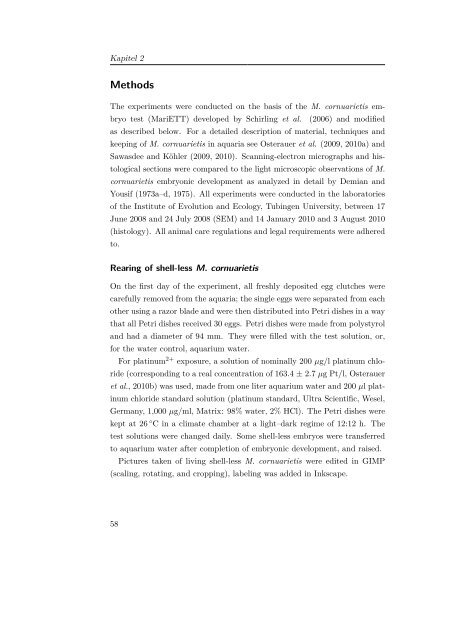Die Embryonalentwicklung der Paradiesschnecke ... - TOBIAS-lib
Die Embryonalentwicklung der Paradiesschnecke ... - TOBIAS-lib
Die Embryonalentwicklung der Paradiesschnecke ... - TOBIAS-lib
You also want an ePaper? Increase the reach of your titles
YUMPU automatically turns print PDFs into web optimized ePapers that Google loves.
Kapitel 2<br />
Methods<br />
The experiments were conducted on the basis of the M. cornuarietis embryo<br />
test (MariETT) developed by Schirling et al. (2006) and modified<br />
as described below. For a detailed description of material, techniques and<br />
keeping of M. cornuarietis in aquaria see Osterauer et al. (2009, 2010a) and<br />
Sawasdee and Köhler (2009, 2010). Scanning-electron micrographs and histological<br />
sections were compared to the light microscopic observations of M.<br />
cornuarietis embryonic development as analyzed in detail by Demian and<br />
Yousif (1973a–d, 1975). All experiments were conducted in the laboratories<br />
of the Institute of Evolution and Ecology, Tubingen University, between 17<br />
June 2008 and 24 July 2008 (SEM) and 14 January 2010 and 3 August 2010<br />
(histology). All animal care regulations and legal requirements were adhered<br />
to.<br />
Rearing of shell-less M. cornuarietis<br />
On the first day of the experiment, all freshly deposited egg clutches were<br />
carefully removed from the aquaria; the single eggs were separated from each<br />
other using a razor blade and were then distributed into Petri dishes in a way<br />
that all Petri dishes received 30 eggs. Petri dishes were made from polystyrol<br />
and had a diameter of 94 mm. They were filled with the test solution, or,<br />
for the water control, aquarium water.<br />
For platinum 2+ exposure, a solution of nominally 200 µg/l platinum chloride<br />
(corresponding to a real concentration of 163.4 ± 2.7 µg Pt/l, Osterauer<br />
et al., 2010b) was used, made from one liter aquarium water and 200 µl platinum<br />
chloride standard solution (platinum standard, Ultra Scientific, Wesel,<br />
Germany, 1,000 µg/ml, Matrix: 98% water, 2% HCl). The Petri dishes were<br />
kept at 26 ◦ C in a climate chamber at a light–dark regime of 12:12 h. The<br />
test solutions were changed daily. Some shell-less embryos were transferred<br />
to aquarium water after completion of embryonic development, and raised.<br />
Pictures taken of living shell-less M. cornuarietis were edited in GIMP<br />
(scaling, rotating, and cropping), labeling was added in Inkscape.<br />
58
















